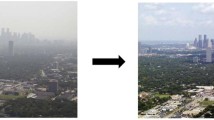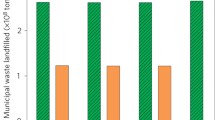Abstract
Current landfills emit copious quantities of methane, which is typically flared on-site. Such flaring results in significant emissions of oxides of nitrogen (NOx), as well as potentially serious levels of toxics, greenhouse gases, and other flare gas contaminants. The district has worked closely with TeraMeth Industries (TMI) to establish the first demonstration plant in the world that will divert the gaseous waste stream from the BKK Landfill, located in West Covina, CA, through a syngas synthesis process, and produce 50 metric tons/d of methanol. Multiple replication of this technology is projected by TMI to be commercially competitive with worldwide methanol production economics. For example, contractual commitments for the long-term purchased product have been obtained. Permitting issues unique to landfills, such as site-specific gas composition, have also been addressed as part of this project. This article identifies:
-
1.
The air-quality context of this facility;
-
2.
The key permitting issues being addressed to facilitate the construction and operation of this facility; and
-
3.
The commercial and economic implications of the plant design, including the potential future markets for this conversion technology.
Similar content being viewed by others
References
South Coast Air Quality Management District, Symposium on the Adverse Health Effects of Air Pollution, March 17, 1995.
South Coast Air Quality Management District, Air Quality Management Plan, September, 1994.
Wuebben, P., testimony to the U.S. Congress, House Subcommittee on Energy and Power, “Reinventing Baseline—The South Coast Air Quality Management District’s Perspective on Low Emission Vehicles and Fuels,” October 7, 1993.
USEPA Office of Air Quality Planning and Standards, “Air Emissions From Municipal Solid Waste Landfills,” EPA Report 450/3-90-011a, March 1991.
California Air Resources Board, “Suggested Control Measures for Landfill Gas Emissions,” September 13, 1990.
USEPA “Engineering Technologies for the Utilization of Landfill Gas; Section 2.3 Production of Methanol From Landfill Gas (TeraMeth Industries),” Report, in press, 1995.
New Fuels Report, “Chevron Signs Renewable Methanol Agreement with TeraMeth,”OxyFuel News, April 24, 1995, “Chevron USA to be Primary Buyer of California Firm’s Biomethanol,” April 24, 1995.
SCAQMD, “Report on TeraMeth Industries Landfill Gas Abatement Facility,” correspondence from Jack Broadbent, Director of Planning, to Jeff Collier, City of West Covina, October 4, 1994.
Dames and Moore, “TeraMeth Industries, Inc. Landfill Gas Abatement/Methanol Production Facility, Initial Study, to City of West Covina December 15, 1993.
Inside EPA’s Environmental Policy Alert “Landfill Technology to Capture Some Toxic Emissions, Convert Methanol” April 26, 1995.
U.S. Army, Publication O-M-232J November 19, 1990.
Dames and Moore, OP. Cit.
California Air Resources Board, “The Landfill Gas Testing Program—Second Report to the California Legislature,” June 1989. “The Landfill Testing Program: Data Analysis and Evaluation Guidelines,” August, 1990.
SCAQMD, Op. Cit., October 4, 1994.
Dames and Moore, Op. Cit.
USEPA “Onsite Engineering Report of Wet Air Oxidation and PACT System Treatability Study at Zimpro/Passavant,” Report “Preparation in Connection with Development of BDAT,” November, 1989. Three Volume Final BDAT Background Document for F039 per NTIS Documents PB90-234337, 234345, 234352.
USEPA, “Simultaneous Sludge Disposal and Powdered Activated Carbon Regeneration. “Contractor/Vendor Report forwarded to TMI July 21, 1994.
SCAQMD, Op. Cit., October 4, 1994.
Bond, R. G., Straub, C. P., and Prober, R., eds. (1977) Stationary source emission factors, inHandbook of Environmental Control, vol. 1: Air Pollution, CRC, Boca Raton, FL.
Pohl, J. H., Lee, J., Payne, R., and Tichenor, B. A. (1986), Combustion efficiency of flares.Combustion Sci. Technol. 50, 217–231.
Communication from Sanitation Districts of Los Angeles to Alan Bonny, TeraMeth Industries, September 10, 1993.
SCAQMD, Op. Cit., October 4, 1994.
Ibid.
Lahi, U. (1991), PCDD/PCDF balance of different municipal waste management methods.Chemosphere 232, 8–10.
Private Communication of John Zinc Co. to TeraMeth Industries, Inc., July 21, 1993 per proprietary vendor burner design and specifications verification.
Communication from EMCO Wheaton to TeraMeth Industries, July 20, 1994.
SCAQMD, Op. Cit., October 4, 1994.
Lisk, D. J. (1991), Environmental effects of landfills.Sci. Total Environment 100, 415–468.
Trash Talk About the Atmosphere (Re: Ontario Ministry of the Environment). Globe and Mail, Toronto, Canada, May 10, 1995.
Mauch, S. C. and Militana, L. M. Statistical modeling of ambient air toxics impacts during remedial investigations at a landfill site.Biol. Abstr. 41.
Tighter Laws Landing on Landfills.Chicago Tribune, October 17, 1993, Section 7, p. 7.
Repa, E. W. (1995),Clean Air Act Requirements for Landfills. Waste Age, pp. 163–170.
California Air Resources Board, “Suggested Control Measures for Landfill Gas Emissions,” Prepared by California Air Pollution Control Officers, Association Technical Review Group, Landfill Gas Subcommittee, August, 1990, p. 32.
TMI Communication to SCAQMD, May 25, 1995.
Communication from Jeffrey Collier, City of West Covina to Alan M. Bonny, TeraMeth Industries, April 10, 1995.
Wuebben, P. “The Implications of the Clean Fuel Bus Success,” World Methanol Conference, November 29, 1993.
Wuebben, P. The South Coast Air Quality Management District’s Clean Fuels Program: Barriers, Issues and Opportunities, inInternational Specialty Conference, Air and Waste Management Association and the Environmental Protection Agency, on PM-10 Standards, November, 1992.
Federal Reserve Bank of Dallas, “Methanol as an Alternative Fuel: Economic and Health Benefits,”Economic Review, September, 1991.
South Coast Air Quality Management District,Building Markets for Low Emission Technologies and Clean Fuels, January, 1995.
Author information
Authors and Affiliations
Rights and permissions
About this article
Cite this article
Wuebben, P., George, S., Watkins, L. et al. South Coast Air-Quality Management District (SCAQMD). Appl Biochem Biotechnol 57, 729–740 (1996). https://doi.org/10.1007/BF02941754
Issue Date:
DOI: https://doi.org/10.1007/BF02941754




